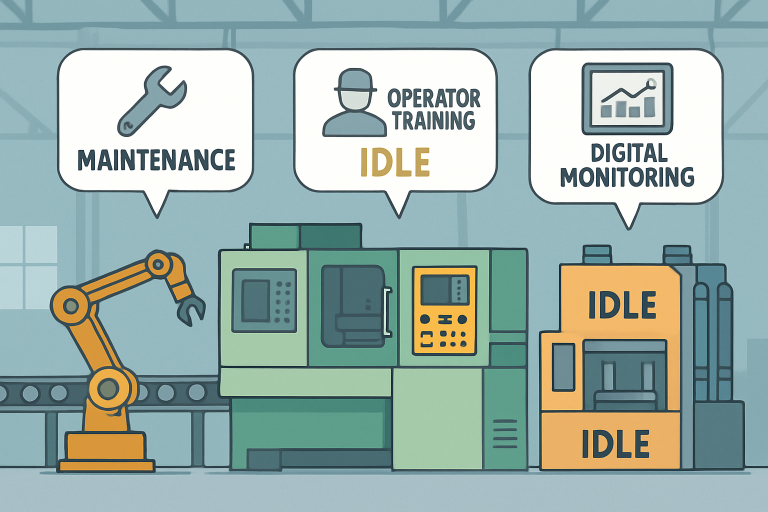In today’s highly competitive manufacturing environment, minimizing equipment downtime is not just a matter of maintaining steady production flow—it is a critical factor for ensuring any factory operation’s overall success and profitability. Whether unplanned or scheduled, equipment downtime inevitably disrupts production schedules, creates bottlenecks, and leads to missed shipment deadlines, which can tarnish a company’s reputation. Furthermore, the costs associated with idle machines go beyond lost output; downtime ramps up operational expenses, impacts supply chain performance, and often results in overtime labor and expedited shipping fees to recover lost time. Staying competitive means adopting robust systems that strive to limit downtime when it occurs and prevent its root causes. Leveraging advanced solutions like machine downtime tracking directly empowers manufacturers to address downtime issues in real time, using accurate data to fuel proactive planning, process optimization, and more intelligent decision-making. These efforts result in higher productivity, steadier profits, and greater customer satisfaction.
A strategic approach to managing downtime enables manufacturers to anticipate emerging issues, respond quickly to malfunctions, and reduce the impact of unplanned disruptions that can ripple across the entire value chain. This holistic approach draws from multiple pillars: implementing innovative digital solutions, investing in predictive and proactive maintenance strategies, upgrading employee skillsets through regular workforce training, and committing to continuous improvement. Each step is vital for ensuring the machinery operates efficiently with minimal interruptions. Emphasizing systematic monitoring, regular performance audits, and data-driven corrective actions gives organizations the comprehensive toolkit to prevent unnecessary stoppages and recover rapidly when issues arise. Collectively, these techniques foster a production environment where problems are anticipated, mitigated quickly, and production targets are consistently met.
Predictive Maintenance
Predictive maintenance uses advanced analytics, AI, and real-time monitoring techniques to forecast mechanical failures before they occur. By aggregating data from equipment—such as vibration analysis, temperature readings, lubricant quality, and runtime hours—facilities can move away from rigid, calendar-based maintenance schedules toward a more flexible, needs-based approach. This shift makes maintenance less reactive and extends the usable life of critical assets. For example, predictive models can flag abnormalities in motor performance or identify early warning signals in conveyor belts, allowing maintenance teams to intervene precisely when needed, thus preventing potentially catastrophic failures. Industry research highlights that predictive maintenance can slash downtime by up to 50% and reduce related maintenance costs by as much as 10–40%. Additionally, predictive maintenance solutions often integrate with computerized maintenance management systems (CMMS), further enhancing traceability and reporting.
Proactive Maintenance
Whereas predictive maintenance focuses on using data to anticipate failures, proactive maintenance eliminates the factors that give rise to equipment issues in the first place. This philosophy is rooted in reliability-centered maintenance and targets the underlying causes of wear and tear, such as excessive friction, misalignment, improper lubrication, and contamination. Core activities include performing regular lubrication routines, conducting alignment and balance checks, replacing worn components ahead of schedule, and using advanced tools like ultrasonic leak detectors and thermal imaging cameras to find hidden weaknesses. By tackling problems while they are still minor and manageable, proactive maintenance protects machinery from large-scale breakdowns that can cripple a production line. When paired with sound root cause analysis, this strategy ensures that chronic issues do not recur and that production assets remain healthy and reliable.
Real-Time Monitoring Systems
Digital transformation in manufacturing has introduced a new era of visibility using real-time monitoring systems. IoT-enabled sensors, PLCs, and interconnected smart devices can be fitted to virtually any production equipment, from pumps and compressors to automated robotic arms. These devices continuously capture critical process data such as motor currents, vibration frequencies, hydraulic and pneumatic pressures, and fluid levels. The value of real-time monitoring extends beyond just collecting numbers—information is interpreted by analytics software that can spot emerging issues before they lead to failure. When anomalies occur—such as a sudden spike in vibration or drop in pressure—maintenance staff receive instant notifications via mobile devices or control room dashboards. This signal allows them to address the problem immediately, minimizing disruption and reducing the risk of costly emergency repairs. Additionally, real-time data builds a historical record that informs continuous improvement and supports data-driven business decisions for maintenance scheduling and asset replacement planning.
Operator Training and Empowerment
Production line operators are a plant’s first point of detection for potential equipment problems; their hands-on, daily interaction with machinery means they can often sense subtle shifts in performance before they develop into full-scale issues. Investing in comprehensive operator training—covering machine basics, safe operating procedures, preventive care, and troubleshooting—empowers staff to identify and address small issues on the spot quickly. Empowered operators are encouraged to take pride in ‘ownership’ of their machines, directly reporting anomalies or even halting production when they suspect a safety or quality risk. Fostering open communication channels, rewarding attentive behavior, and embedding a ‘stop-and-fix’ culture can dramatically improve equipment lifespan. Furthermore, ongoing refresher training and knowledge sharing between shifts ensure that operational know-how is retained, contributing to a safer, less disruptive production environment over time.
Standard Operating Procedures (SOPs)
Developing and maintaining robust standard operating procedures (SOPs) is essential to achieving consistent, error-free operation and maintenance routines. Precise SOPs detail every critical step in processes such as machine start-up and shutdown, inspection checks, calibration, cleaning, and scheduled servicing. These documents function as a reference point for both veteran operators and newly hired staff, reducing training time and eliminating uncertainty about ‘the right way’ to perform essential tasks. As a result, the likelihood of skipped steps or human error is dramatically lowered. Recording procedures also provides a mechanism for identifying where and why downtime incidents occur—feedback that can drive continuous improvement across teams. Reviewing SOPs regularly and updating them based on the latest equipment upgrades, inspection findings, or input from frontline employees ensures that these procedures stay effective and relevant in a dynamic production environment.

Automated Downtime Tracking
Traditional, manual methods for logging machine stoppages—such as clipboards or spreadsheets—are often prone to errors, inconsistencies, and loss of detail. Automated downtime tracking systems overcome these limitations by providing a real-time, digital log that categorizes every incident by cause, affected equipment, and duration. This data is automatically captured—often directly from IoT sensors—offering a comprehensive, objective record of every downtime event. Over time, this enables maintenance and production teams to analyze root cause trends and identify recurring bottlenecks. Intelligent reporting tools can highlight problem areas requiring investment, whether in training, spare parts, or process adjustments. The result is a continuous feedback loop in which improvement actions are grounded in reliable data and measurable outcomes. With automation, teams spend less time entering and deciphering data and more time acting on meaningful insights.
Regular Equipment Audits
Periodic equipment audits are the cornerstone of a proactive maintenance program. These structured inspections involve a deep dive into each asset’s operational state, from reviewing basic wear and tear to checking for compliance with regulatory standards and safety guidelines. During audits, trained technicians evaluate alignment, cleanliness, lubrication status, and even the adequacy of machine guarding. They may also assess whether software or firmware updates are needed. Catching minor defects before they evolve into major failures curtails unplanned downtime, helps prevent fines and penalties for noncompliance, and keeps insurance costs in check. Tracking audit results over time enables plants to adjust maintenance plans based on actual asset performance and demonstrates continuous improvement to customers and inspectors alike.
Utilizing Shared Dashboards
Digital dashboards have transformed manufacturing teams’ management of equipment health, efficiency, and downtime mitigation. By visually consolidating key metrics—including OEE (Overall Equipment Effectiveness), machine states, recent outages, and maintenance history—shared dashboards enable everyone from frontline staff to senior management to make fast, informed decisions. Accessible dashboards nurture transparency between departments such as operations, engineering, and maintenance, breaking down communication barriers and ensuring everyone sees the same information in real time. When a critical downtime occurs, notifications are instantly escalated, and collaborative teams can triage and resolve the issue more efficiently.
Reducing equipment downtime in manufacturing demands an ongoing, multi-faceted strategy—integrating modern technology, continuous workforce development, rigorous adherence to standardized processes, and an unrelenting focus on actionable data. By employing these comprehensive practices, manufacturers can mitigate risk, foster a culture of reliability, and secure the operational excellence necessary for enduring success and growth in today’s fast-paced market.

